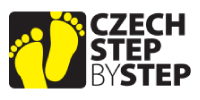Tips and Ideas
For Students
Enjoy learning Czech. Find something you enjoy doing and do it in Czech. Listen to songs, watch films, listen to the radio, read comic books…
Language is inevitably linked to the place where it’s spoken and its culture. Take “ty” and “vy” for example. Even though the formal and informal variations exist in other cultures, it may not be used in the same way. In one country you may use the informal variation in a restaurant, but if you do it in the Czech Republic, you will sound very rude. There are some expressions and gestures that can only be understood by their connection to reality (e.g. “držím palce”, the use of the word “pohodlný”, “v pohodě” etc.) So don’t lock yourself up in the books: look around and see how people use the language.
Write a Czech diary. Try writing a little about your day in Czech. Try to do it every day or every week. Are you going on a holiday? Excellent opportunity! Maybe you can select a couple of photos and write comments about them, or just a couple of words.
When you are learning new vocabulary (e.g. things around the house),you can put labels with these words in Czech on the actual thing (e.g. stick a label marked “zrcadlo” on your mirror etc.) That way you learn every time you look at the object. Done naming the objects? Do the same with verbs (“dívat se” on your mirror) or adjectives (“lesklý” on the mirror) etc.
It’s good to have some Czech learning routine: maybe reviewing words from the lesson every evening or every Saturday, watching a short video in Czech on stream.cz every Wednesday morning, writing something in your Czech diary every Sunday during breakfast, or taking a photo of one Czech billboard every week. Find something that works for you and do it regularly. Then the force of habit will call you to do it.
Do you have a calendar at home? Why not write one Czech word under each day? That will be your word of the day. Try to use it in sentences during the day and practice it. At the end of the week, you can review all of your new words. Having a Czech calendar is also practical for revision of names of days and months (which are usually a challenge for students). When you see them every day, you are more likely to remember them.
If you want to practice listening, don’t read. By that I mean: don’t read at the same time. First listen, try to understand what you can, and then read subtitles or accompanying text. Many students complain that they don’t understand when they listen, and often it’s because they don’t practice listening but rather reading: as they listen, they are really focused on the text.
Many textbooks come with excellent audio resources, but you should also explore Czech songs, videos (with subtitles that can be turned off), or stories, such as adaptovaná próza from Czech Step by Step or Krátké české zprávy, both of which offer audio online.
Reading will probably not improve your speaking skills. To get better at speaking, you need to speak (of course) but also to listen. Listening is the passive equivalent of speaking, as reading is the passive equivalent of writing. Reading and writing represent the visual language, listening and speaking are the audio language. Altogether these are the four skills students should develop. If you notice that one skill is lacking, try to do more practice focused on that one. In this way, you can build a larger passive database of the visual or audio language (by reading or listening), and then applying it practically (by writing or speaking). Don’t be disappointed if you cannot use all the language that you know on a theoretical level. That’s absolutely normal. Your passive knowledge will always be larger that your active ability to use it. I bet it’s the same in your mother tongue: you probably understand more words than you use.
Don’t use just your head and hands, apply the whole body. Clap the number of syllables of a word, dance the intonation of a sentence, walk up the steps and count in Czech, say the days of the week or months, make flashcards with words and turn them over to check the definition on the other side, draw a picture for new words you learn, record yourself on your mobile and listen to your speech. Experiment. Have fun.
It’s much nicer to follow a story than study isolated sentences and grammar rules. Find a book that you might like and read it!
If your Czech is not yet at a very high level, it’s best to find an “adapted book” (that is, specially adapted for students of Czech) so that you will be able to understand it but still learn something new. If your Czech is less advanced and you attempt to read a Czech book in the original, no matter how motivated you are at the beginning, there is a good chance you will run out of steam just a few pages in. Mirror texts don’t help much either, because the original remains difficult. Fairy tales seem easy, but often are not. All those adjectives to describe the characters, old fashioned verbs, special fairy tale phrases… Still, anything is possible with enough motivation. Find something suitable for your level (magazine articles, recipes, blogs, short stories, detective stories…), something you enjoy and start! You can find some adapted prose for various levels in the books by the Czech Step by Step team.
If you want shorter texts, there are interesting articles on various topics and for three different levels of Czech in the magazine AHOJ.
Do you like cooking? That can be an excellent way to practice Czech. Cook a Czech dish. Follow a Czech recipe. Study the genitive in the list of ingredients. Study the imperative in following the cooking instructions. Study the perfective and imperfective of the verbs describing what needs to be done while you cook. Make a list of your Czech recipes. Add photos of your cooking successes (or disasters). And then eat it with your family or friends and make them all enjoy your Czech cooking training.
It’s not just foreigners who study Czech, but also Czechs at school! And there are many materials for them. It’s true that you’ll probably need to be a bit selective and find your right level, but there is so much to choose from.
Look for example at Edu Česká televize a website run by Česká televize designed to help students with education online, especially during the Covid era. You can choose a subject that you are interested in (e.g. history, biology or Czech), or search by age of the children for whom the videos are intended. The videos are often short and have subtitles. You can study any subject you want: by using Czech in the process, you will learn Czech without even trying.
For Teachers
Don’t be afraid to sometimes give students the role of teacher. Make sure you demonstrate the activity first, but then let the students have a go. They can ask other students (or you) questions. They can check each others’ writing. They can give a small presentation, teach you about their country, culture, their job, their favourite recipe etc. Let them feel powerful using Czech as their own tool to communicate what they know better than you
Think about the space where you are. Change the seating order, make students move, make them get up. Why? Making them physically active pumps more blood to the brain and they’ll feel less sleepy. We learn with our bodies, not just with our heads. Can you cut up the text to be read, put it on the wall around the room and let students walk around with answer sheets and note down the answers at their own pace? Divide the whiteboard in two parts and organise a writing competition for two teams of students? Let students swap places and check the answers on the table after a card matching activity? Go to the main square and let students ask random people for directions to the station (after you’ve studied the phrases at school)? There are a million ways to use the space you’ve got. Look around and get inspired.
Let the students do the talking. Does it need to be said? Can a student say it instead? Could you use a gesture instead? You can for example put your hand to your ear instead of saying: “Now we are going to listen to an audio.” You can point to a page number instead of saying : “Open your books to page thirty four”. Sometimes teachers like to talk. But the teacher’s job is not to give a monologue presentation on the dative case, but to make students speak, deduce grammar rules, correct themselves, and see the logic. In short, provide a lot of cues and give them the opportunity to use the language. Make space for the students. If you speak too much, there will not be time for your students to speak. Limiting the “teacher talking time” will save your vocal cords and make your students pay more attention to the things you actually do say.
Let your students experiment with the language, try new daring sentences and connections, not just play it safe and repeat sentences like a robot. There are times when it’s important to correct (e.g. the drilling phase of a new language acquisition), but there are times when developing fluency and independence is more important. The mistakes also provide important feedback for you: the mistakes students make tell you about their understanding at this moment. If a student says “budu jít”, it means they have correctly learnt the future tense of the regular verbs, but don’t know yet that the verbs of motion are different. So it’s a very good mistake and you can compliment your student on it.
Maybe they need more practice. There is an estimate that 20% of the lesson should be instruction and 80% practice. Initially, practice is “controlled” (e.g. drilling the pronunciation of a new word; filling out an exercise practicing the accusative case), then “semi-controlled,” where students follow instructions to use the new language (e.g. using the new word in a longer sentence; selecting from a menu of things to order in a restaurant, using the accusative case),and finally “free practice” (e.g. using the new word in a new context; role-playing a situation in a restaurant, for which the student needs the newly learnt accusative case). Gradually, the control of the teacher decreases, and the independence in decision making of the student increases.
What you have covered in a book is maybe not what your students have learnt. Keep checking what your students know. Let them prove it: wait for them to answer the questions. Don’t assume they know something just because you did it last year.
To learn 20 new words in a lesson plus the instrumental plural for all the genders? Does it sound like a good plan? Unless your students are geniuses, don’t have regular jobs, don’t have family and have no hobbies outside of Czech, it’s probably not going to work. It is recommended to teach about 7 new words per lesson or one grammar point. Don’t expect too much. Bearing in mind, that each student is different, and can go at different pace.
Do you use “ty-form” when you speak to new people? What is worse: if your students say “ty” to a policeman or “vy” to a friend? As you don’t use the “ty” form and informal phrases like “Ahoj”, when you meet someone for the first time, we suggest you don’t use it with your new students either. This, of course, is a matter of personal preference, and very much depends when your students will use their Czech. If only within their family, sure: “ty” is fine. But if they want to use Czech in a restaurant, a shop, in an office etc., maybe it’s more practical to start with “vy”.
The students want to learn Czech, not English (or German, French, Spanish, Russian or whatever other language you have in common). There is always a common language of pictures, gestures and situations. If you point to yourself and say: “Jsem Staňka,” will they not understand? If you point to the Czech Republic on a map and yourself and say “Jsem z České republiky,” will they not understand? If you approach them with a glass of water and ask them: “Dáte si vodu?” will they not understand? And let’s be honest, is your English really as good as the English of your student from, say, Scotland? Why force your Spanish or Japanese student to learn English as well, if they really want to learn just Czech? How do you translate “locative case”, “masculine inanimate” or “perfective aspect”? Moreover, it’s not just words that get translated, but the whole language structure. How do you make sure that your students will not form sentences influenced by the logic of a different language, like “Jsem teplý” (when what they really want to say is “I’m warm.”) or “Je to generální problém” (when what they really want to say is “That’s a general problem”). Translation only slows down the student’s ability to think in the target language (i.e. Czech) and creates a psychological block.
Check their understanding of your instructions. Try to give the instructions simply. Maybe one sentence is enough, maybe a gesture is enough, maybe you can just point at an exercise and ask students: “What do you have to do?” You can also ask them: after giving instructions, ask them e.g. 3 simple questions, to which they will need to answer yes, no, or something similarly simple. For example, “Will you write?” (Yes), “Can you work together?” (No), “How many minutes do you have?” (3). If some students understand and others don’t, why not let a student who understands explain to others out loud (even in their mother tongue)? This may be better than their whispering and looking around uncertainly.
When there is time for your students to work on something, give them space, stay silent, and let them think. Just because there is silence, it does not mean there is no learning happening. The teacher doesn’t need to fill the gap by reformulating the question, trying to help, doing this and that. Stay calm. Ask one question, wait for an answer. If no answer is forthcoming, try to help. With some students you may need more patience: don’t get stressed out, silently count to five, ask again, count to five again and then if nothing happens, maybe ask someone else or try something different. But give them time. Wait and listen.
No matter how much you try, there will always be things to learn. There will always be people who do some things better than you. But that’s ok. Be content with doing what you can do well, find your teaching style, do what works for you and look at others to get inspired. You don’t need to be the master of everything. Stay calm and enjoy the best job in the world – teaching. If you enjoy the lessons, your students will also enjoy them.
Especially for low level students, make your language simple. Simple sentences, simple words, no slang or dialect (or, at most, a very small amount). Speak clearly and plainly. Think about every word you say. At the beginning it helps to write in your lesson plan a transcript for yourself—every word you are going to say. “Dobrý den. Já jsem Staňka. A vy? Jsem z České republiky. A vy?” or “Co je to? Kde je káva? Ano, obrázek tři. Super!” etc. Do not say the same thing twice (“Co je nového? Co jste dělali?”) or pile up one question after another (“Co jste dělali včera, jako kde jste byli a tak.”) Do not use complicated sentences (“Až to budete mít hotové, tak si společně zkontrolujte odpovědi a podívejte se, jestli to máte stejně” will work less well than “Hotovo? Co má Marian? Je to stejné?”)
Don’t just wait for the students to finish talking so that you can ask them another question on your list. Don’t think during their response about what you are going to do next. Listen actively. Listen to the meaning of their words, not just the grammatical mistakes. Regard your students as human beings, not just empty vessels that you need to fill with information. When you approach your students like that—you remember how many kids they have, what their hobbies are, where they went on holidays, and so on—you can better adjust and personalise the textbooks activities to make them more interesting for each individual student, to create a better rapport with them and make the general atmosphere of lessons more friendly and home-like.




